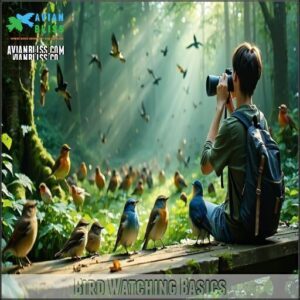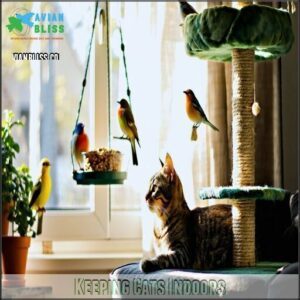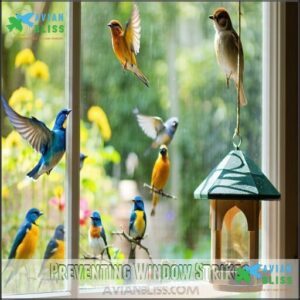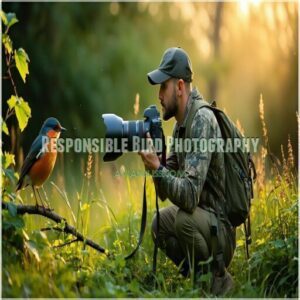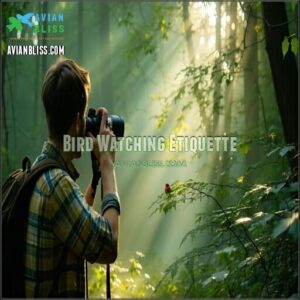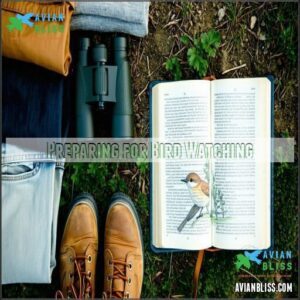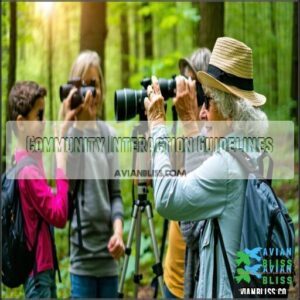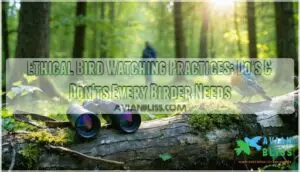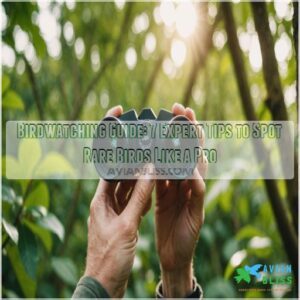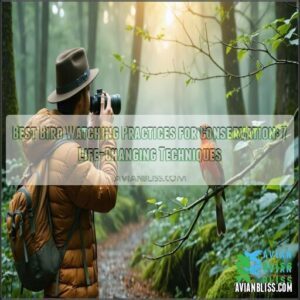This site is supported by our readers. We may earn a commission, at no cost to you, if you purchase through links.

Avoid loud noises, quick movements, or using recorded bird calls, as these can stress birds. Wear neutral, earth-toned clothing to blend in and reduce visibility.
If a bird seems agitated or starts calling loudly, step back—it’s their version of yelling, “Back off!” Refrain from disturbing nests or getting too close to young birds.
Instead, enjoy the thrill of spotting them without interfering. Respecting nature helps you see more while keeping the birds safe—win-win! Ready for even smarter birding? Keep reading to learn more about bird watching, respecting nature, and how to keep birds safe with smarter birding.
Table Of Contents
Key Takeaways
- Stick to trails, move quietly, and wear neutral tones to blend in and keep birds relaxed.
- Use binoculars or zoom lenses to observe from a distance without disturbing birds or their natural habitats.
- Recognize alarm calls and step back immediately if a bird seems agitated or stressed.
- Avoid nesting areas, loud noises, or using recorded calls that might disrupt natural behaviors.
Bird Watching Basics
You’ll spot more birds while causing less stress when you master the basics of respectful observation.
Respect wildlife by observing from a distance; true beauty lies in witnessing birds’ natural behaviors without causing them stress.
Keeping a safe distance and using optical tools lets you witness natural behaviors without disrupting the very wildlife you’ve come to admire, which is key to mastering the basics.
Maintaining Safe Distances
The golden rule of bird watching is keeping your distance. Maintain at least 100 feet from most birds to minimize stress and disturbance.
When approaching sensitive species, especially during shorebird incubation periods, move slowly and watch for signs of alarm. Using optical devices lets you observe from distance while responsible birding practices guarantee birds maintain natural behavior.
For enhanced viewing, consider options like high magnification binoculars. Remember, the best sightings happen when birds don’t know you’re there.
Using Binoculars and Zoom Lenses
During field observations, your binoculars and zoom lenses are essential tools to minimize bird disturbance.
The right magnification choices (8x to 10x for binoculars) let you observe from distance while maintaining a good field of view.
Look for image stabilization in higher magnifications and quality lens coatings for better clarity.
Ergonomic design matters too—you’ll watch longer when your equipment feels comfortable.
Selecting binoculars with BAK4 glass prisms can also improve image sharpness and provide a better viewing experience with good field of view.
Recognizing Alarm Calls
While binoculars help you see birds from afar, learning to listen is equally important.
Birds have distinct alarm calls that signal distress. When you hear rapid, repetitive chips or harsh scolding sounds, birds are telling you you’re too close.
These disturbance indicators vary by species, but all require the same response: back away slowly. By recognizing alarm calls and retreating, you’ll minimize bird stress and observe more natural behaviors.
Minimizing Habitat Disturbance
The habits you develop while birdwatching directly impact the health of bird habitats. Once you’ve mastered the basics of distance and observation, it’s time to focus on protecting their homes.
Trail etiquette isn’t just good manners—it’s essential for habitat protection. Stay on marked paths to prevent soil erosion and habitat damage. When you wander off-trail, you might unknowingly crush native plants that birds depend on for food and shelter.
Minimize disturbance by keeping your voice low. Birds are sensitive to noise, and loud conversations can drive them away from feeding or nesting areas. If you bring pets, maintain strict control. Even well-behaved dogs can frighten ground-nesting species.
Help with invasive removal when possible—many parks have volunteer programs. Non-native plants reduce biodiversity and limit resources for native birds. One way to help is by planting native trees, which provide natural food and shelter.
Avoid nesting areas completely during breeding season—your presence alone can cause parent birds to abandon their young.
Bird Friendly Practices
You can help birds thrive beyond your binoculars by adopting simple practices at home that create safer environments for our feathered friends.
Help birds thrive by creating safe spaces at home—plant natives, prevent window strikes, and keep cats indoors.
These bird-friendly habits protect local populations while enhancing your backyard birdwatching experience.
Keeping Cats Indoors
After protecting habitats outdoors, let’s look at what you can do at home.
Keeping cats indoors isn’t just good for birds—it’s safer for your feline too.
Indoor cats live longer (15+ years versus 2-5 for outdoor cats) and don’t contribute to the estimated 2.4 billion birds killed annually by cat predation.
Create indoor enrichment with cat trees and toys to minimize disturbance to local bird populations, which is a safer option for your cat and helps reduce the number of birds killed by cat predation, ultimately supporting a longer life for your feline.
Preventing Window Strikes
While your indoor cats stay safe, many wild birds don’t fare as well against glass.
Window strikes kill millions of birds yearly. You can prevent these collisions by applying decals following the 2-inch rule—no untreated areas larger than 2 inches.
Place feeders within 3 feet of windows to reduce impact speed. External screens, bird-safe glass treatments, and products that minimize interior reflections also create safer spaces for your feathered visitors.
You can find effective window safety stickers online, which can help prevent window strikes and make your home more bird-friendly with safer spaces.
Conserving Water and Reducing Waste
During your birding adventures, remember that conserving water and reducing waste directly benefits birds.
Install rain barrels to collect water for bird baths and gardens. Carry reusable bottles and avoid single-use plastics that might end up in habitats.
Pack out what you pack in, leaving no trace of your visit. Small changes in your sustainable birding practices create healthier environments for our feathered friends, and this can be achieved by making a few simple adjustments to reduce waste and conserve resources, ultimately supporting conserving water and promoting a better habitat through reducing waste.
Planting Native Trees and Vegetation
While you save water, you can also create your own bird sanctuary with native plants.
Research shows native landscaping supports local birds better than feeders.
Oaks, known as "the mighty oak," support more butterfly and moth species than any other plant, providing abundant bird food.
- River Birch attracts hundreds of butterfly species while its bark shelters invertebrates
- Serviceberry trees offer flowers, fruits, and nesting cover in one bird-friendly package
- Eastern Red Cedar produces fruits that songbirds eat during migration
- Native plants require minimal water and fewer pesticides for sustainable birdfriendly gardening
- Viburnums like Blackhaw and Arrowwood provide fall berries for songbirds
To further enhance the habitat, consider planting native mid-level trees for nesting.
Responsible Bird Photography
You’ll capture better bird photos while protecting their wellbeing when you maintain a safe distance and use long lenses instead of approaching too closely.
Your photography choices directly impact bird behavior, so avoid using flash or baiting birds to get the perfect shot, and remember to prioritize their wellbeing.
Respecting Nesting Sites
Keep your distance from nesting sites to guarantee fledge success. During incubation periods, even brief visits can stress parent birds, sometimes causing nest abandonment.
Maintain at least 100 feet from active nests and use your longest lens. Watch for signs of distress—if birds chirp nervously or feign injury, you’re too close.
Habitat protection starts with respecting these sensitive areas and understanding the impact of your presence, which is crucial for the well-being of the birds, thus ensuring their nest abandonment is prevented.
Avoiding Baiting and Luring
While protecting nesting sites remains essential, you’ll also want to resist the temptation to lure birds closer with food.
Though possible, baiting creates unnatural dependencies and alters natural foraging behaviors. Ethical food placement isn’t just about legality—it’s about respect.
When birds become dependent on human-provided meals, they may lose essential survival skills.
Instead, appreciate their natural behaviors from a respectful distance using your camera’s zoom capabilities. To further minimize your impact, consider how sustainable birding practices can help protect bird populations, promoting sustainable and ethical birdwatching.
Prioritizing Bird Well-being
While baiting alters natural behaviors, prioritizing bird wellbeing means always putting the birds first.
Watch for signs of stress—fluffed feathers, alarm calls, or erratic movements. If a bird shows these signals, back away quietly.
Ethical birding requires patience and respect. You’ll actually observe more authentic behavior when birds don’t feel threatened.
Remember, a photo isn’t worth causing distress to the very creatures you admire.
Using Long Lenses and Natural Environments
While prioritizing birds’ well-being remains paramount, your equipment choices matter too.
Invest in a long lens (300mm+) to capture detailed images from safe viewing distances.
Natural environments work best—use existing blinds, your vehicle as a hide, or natural camouflage like bushes.
Shoot in natural light whenever possible, avoiding flash that startles birds.
You’ll get better photos while practicing ethical photography that respects habitat preservation and guarantees minimal disturbance.
Bird Watching Etiquette
You’ll find that proper bird watching etiquette puts the welfare of birds first while enhancing your viewing experience.
By keeping a respectful distance and using the right equipment, you’ll observe more natural behaviors without causing stress to these sensitive creatures, which is key to a good viewing experience.
Prioritizing Bird Welfare
The heart of ethical observation lies in putting birds first.
You’ll see more natural behaviors when you minimize disturbance by staying at proper distances and recognizing bird stress signals.
Don’t approach nesting areas or use calls that might disrupt feeding or mating rituals.
Your responsible actions protect both individual birds and their communities, ensuring that bird watching remains sustainable for generations to come.
Supporting Conservation Efforts
Beyond simply watching birds, your actions can directly contribute to their survival.
Support conservation efforts through these meaningful steps:
- Join citizen science projects like eBird to track bird populations
- Advocate for habitat protection policies at local and national levels
- Reduce your carbon footprint when traveling to birding locations
- Participate in community engagement events focused on bird conservation efforts
Every responsible birding choice helps minimize disturbance and protect the creatures we love to observe, which is crucial for their survival and our ability to continue birding.
Fostering Community Respect
A birder’s reputation extends beyond individual actions to the entire community.
Good etiquette means sharing scopes with newcomers and taking turns in groups. When you spot rare birds, verify sightings before reporting them.
Share your knowledge respectfully and only when welcome. Inclusive birding creates a positive environment where everyone feels valued.
Remember, group etiquette strengthens the community and guarantees everyone enjoys the experience.
Ensuring Legal Compliance
Respecting fellow birders is only half the equation; you must also follow the law when birding. Birdwatching regulations protect both birds and their habitats from harmful disturbances.
Here are three key legal considerations:
- Check permit requirements before visiting protected areas
- Learn habitat regulations for sensitive species in your region
- Report violations of access restrictions to proper authorities
Knowing birdwatching laws helps guarantee public property remains accessible to all wildlife enthusiasts for generations to come. Native birds also receive legal protection under federal law. This ensures that wildlife enthusiasts can enjoy birding while preserving the environment.
Preparing for Bird Watching
You’ll need proper equipment and subtle techniques to observe birds without disturbing them.
Good preparation includes selecting neutral-colored clothing, quiet footwear, quality binoculars and a field guide to identify species from a respectful distance, which allows for quality observation.
Essential Equipment and Gear
Now that you understand the importance of bird welfare, let’s look at your gear. Quality binoculars are your top priority—opt for 8×42 magnification for a good balance of detail and stability.
Consider purchasing 8×42 binoculars for superior viewing. Pack your backpack with weather protection, water, and snacks.
Spotting scopes help with distant viewing. Choose muted clothing in earth tones and wear comfortable, quiet shoes to move stealthily through natural areas.
Field Guides and Notebooks
Once you’ve got your binoculars ready, grab your field guide and notebook.
A good field guide helps with quick, accurate bird identification without disturbing them for a closer look.
Your notebook serves as both a memory aid and data collection tool.
Jot down details like markings, songs, and behaviors to improve your identification skills over time.
These simple tools let you watch birds without intruding on their space.
Appropriate Clothing and Footwear
Now that you’ve got your field guides ready, let’s talk about what to wear.
Choose earth-toned clothing and camouflage patterns that blend with natural surroundings.
Quiet footwear with soft soles minimizes your impact on the environment and reduces noise that might startle birds.
Weather protection through smart layering strategies keeps you comfortable in changing conditions.
A comfortable fit guarantees you can move freely while maintaining a low profile in the field.
Quiet Movement and Communication
Now that you’re dressed for success, focus on your movement and communication.
Silent footsteps and muted voices are key to seeing more birds. Walk slowly and deliberately, placing your feet carefully to avoid startling wildlife.
When with others, use hand signals instead of speaking. Maintain group awareness while keeping a respectful volume.
Birds respond to quieter observers by continuing their natural behaviors rather than flying away, and it is crucial to maintain silent footsteps and muted voices.
Community Interaction Guidelines
You’ll make better birding connections when you report rare sightings responsibly and welcome newcomers to your observation spots.
Your actions build a community that values both the birds we watch and the people who share our passion for conservation.
Reporting Rare Bird Sightings
Now that your gear is ready, let’s talk about spotting rarities in the wild.
When documenting rare bird sightings, take detailed notes on plumage, behavior, and vocalizations. Submit reports through eBird or local bird clubs for verification process.
Practice ethical sharing by omitting exact locations of sensitive species. Consider conservation impact before posting GPS-embedded data on social media.
With data accuracy, your observations can help protect birds while maintaining confidentiality.
Promoting Inclusive and Respectful Birding
Beyond reporting rare sightings, our birding community thrives on inclusion and respect.
Share your knowledge with newcomers and welcome diverse birders into the fold. Good birding etiquette means creating accessible experiences for people of all abilities.
Support mentorship programs that spread ethical birding practices through respectful dialogue. Remember to always minimize foot traffic to protect habitats.
Remember, your actions shape our community’s reputation. The birds bring us together, but how we treat each other keeps us coming back, emphasizing the importance of respect and good birding etiquette.
Frequently Asked Questions (FAQs)
How can night birdwatching minimize disturbance?
Imagine tiptoeing through a quiet forest—minimize disturbance by using red or dim lights, speak in hushed tones, and keep your distance.
Avoid startling birds with bright flashlights or loud noises to observe responsibly.
Are there tips for birdwatching during migration?
Stick to trails, use binoculars instead of getting close, and avoid scaring birds by staying quiet.
During migration, rest stops are critical for birds, so don’t linger near feeding areas or crowded spots.
How does weather impact bird disturbance levels?
Weather affects bird disturbance by changing their stress levels and behavior.
Harsh weather, like storms, may heighten their vulnerability, so avoid close interactions.
Cold or rainy days can make birds more sensitive to noise and movements, and this can be a critical factor in bird disturbance, thus avoid close interactions during such weather.
What are best practices around urban bird habitats?
A stitch in time saves nine—plant native trees and shrubs for food and shelter.
Keep outdoor cats inside.
Add bird-safe decals to windows.
Reduce noise and light pollution to maintain a peaceful haven for urban birds.
How to handle accidental nest or egg discovery?
If you find a nest or eggs, don’t touch them.
Step back calmly and avoid lingering.
Disturbing nests may scare parents away.
Report threatened species to wildlife authorities, but keep locations private to protect them.
Conclusion
Bird watching is like stepping into nature’s living masterpiece, but it’s up to you to keep the canvas intact.
Stick to marked trails, use binoculars for a closer look, and recognize when birds need space.
Avoid loud noises or anything that could disrupt their habitat. Wear neutral tones, move quietly, and respect nesting areas.
By following these bird watching tips for minimizing disturbance, you’ll see more while keeping birds safe. A little care goes a long way!
- https://www.birds.cornell.edu/landtrust/aba-code-of-birding-ethics/
- https://www.bird.bot/post/birding-ethics-responsible-birdwatching-practices-to-protect-our-feathered-friends
- https://www.ontarioparks.ca/parksblog/ethical-birding/
- https://www.aba.org/aba-code-of-birding-ethics/
- https://www.undp.org/belarus/stories/artificial-nesting-way-care-birds

